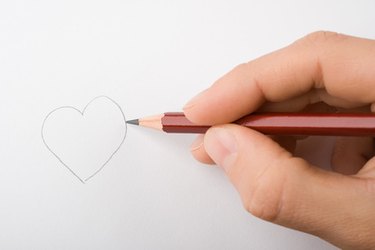
Lines play an integral role in the creation of art. Lines serve as an artist's fingerprint and function as one of her fundamental tools. When an artist produces enough lines on a piece of paper or canvas, the artwork begins to assume both its shape and meaning. Artists make lines using a variety of media, including pencil, pen and paint.
Identification
Video of the Day
Lines in art serve a number of functions, according to authors Enstice and Peters in "Drawing: Space, Form and Expression." In the most basic sense, the line captures the essence and the shape of an object. An artist creates the illusion of three-dimensional space by drawing lines on paper. Finally, an artist uses lines to prepare for the drawing process, much like a singer who sings the musical scales.
Video of the Day
Exercises
According to "Building a Drawing," sketchbook line drawing exercises are some of the fundamental artist tools. Drawing lines in a circular, looping or cross-hatch fashion helps an artist loosen up. The resulting exercises amount to scribbling lines in a sketchbook, but they serve a serious purpose. They prepare the artist physically and mentally to draw. After the artist warms up, she can then move on to another type of line drawing, called the gesture drawing. In the gesture drawing, the artist captures the structure and the movement of an object in loosely drawn lines.
Capturing the Outline
In addition to using lines to capture an object's movements, the artist employs lines to draw the shape of an object. These line techniques are known as contour, blind contour and continuous line drawings. An artist might describe the contour line as a subject's outline. The blind contour line drawing does this as well, but the difference between the two lies in execution; the artist does not look at his paper as he draws the blind contour. He seeks only to understand the shape of an object and draw it. Finally, the artist can make a continuous line drawing to help him understand the shape of an object. In this instance, he does look at his paper, but doesn't remove his hand from the paper for the duration of the drawing.
Three-Dimensional Space
Artists create the illusion of three-dimensional space on paper with vertical lines, according to Enstice and Peters. This is effective because of how people experience the world from a visual sense. The vertical line signifies the human experience of standing upright. The horizontal line captures the feelings of orientation that people get from looking at the horizon. These types of lines represent visual stability, because they remain static. The vertical line suggests action and doesn't have the axial equivalent of the vertical and horizontal line; this creates the illusion of space.
Design
Although artists use lines in drawing exercises, they also use them to execute their work. Enstice and Peters write that the artist can use gesture drawing as a stepping stone for creating a design. An artist makes loose sketches or preparatory drawings of a painting, poster or even a brochure. She uses gesture drawings to capture her ideas on paper. Finally, all drawings to a certain extent begin as a series of lines that the artist refines to create a final product.